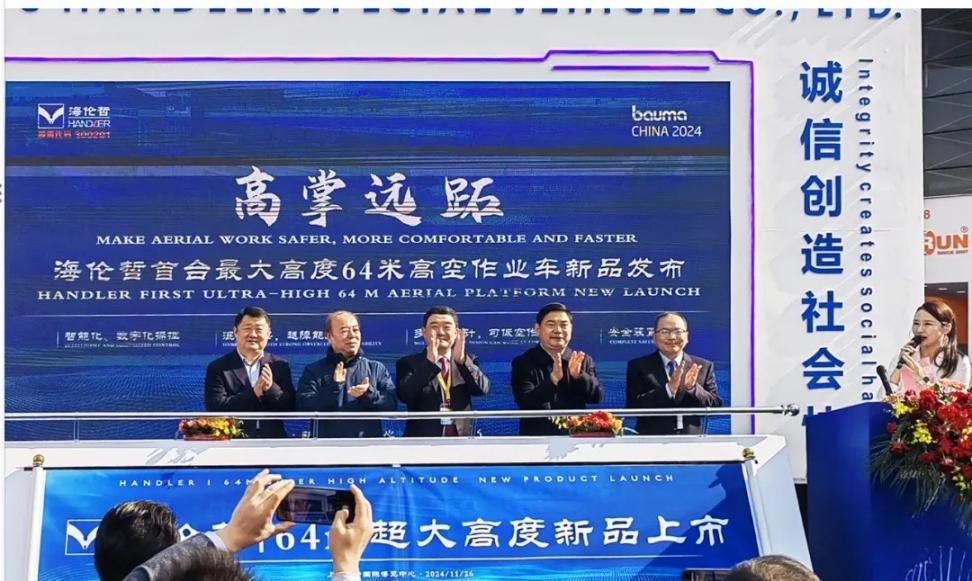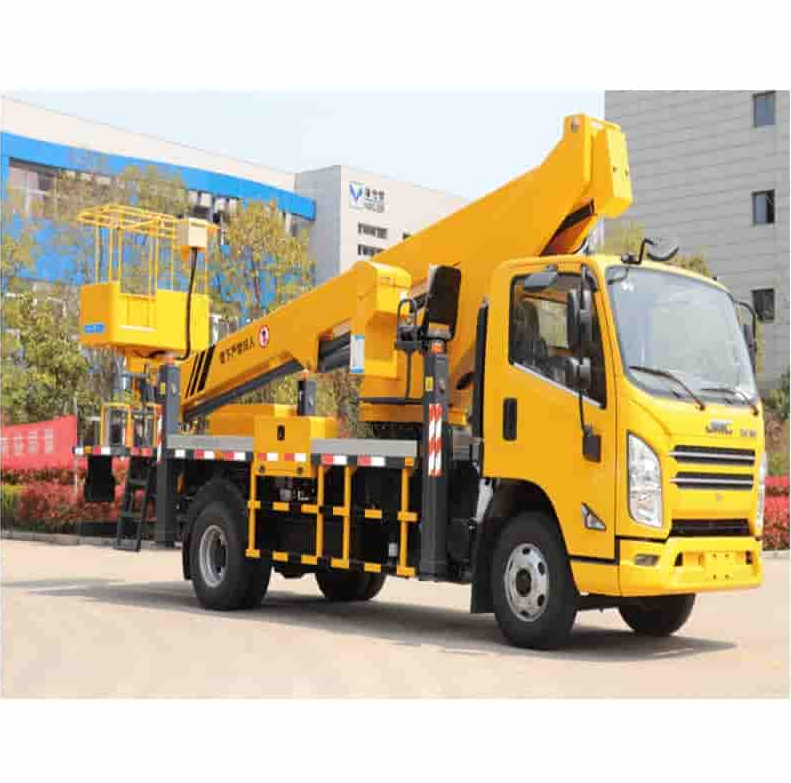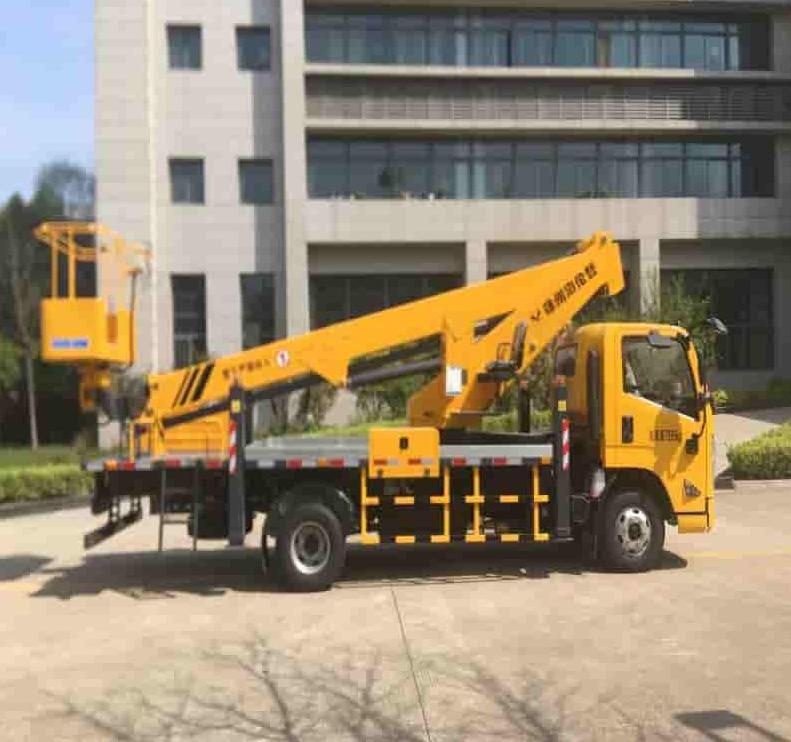What is a Truck-mounted Aerial Work Platform and How Does It Work?
By hqt

Exploring the Power of Aerial Work Platforms for Complex Tasks
Imagine needing to reach a height of 20 meters to complete a critical task—be it for maintenance, construction, or installation. What if you could have a mobile platform that could easily transport workers and equipment to those heights, in even the most challenging environments? This is where truck-mounted aerial work platforms come in, offering a versatile solution to industries that require elevated work access.

A truck-mounted aerial work platform (AWP) is a vehicle-mounted piece of machinery that provides workers with elevated access to hard-to-reach areas, typically in construction, maintenance, and various industrial sectors. It combines the functionality of an aerial lift with the mobility and transportability of a truck. Equipped with a hydraulic lifting system and a bucket or platform, these machines allow operators to safely work at significant heights, ranging from several meters to over 20 meters, depending on the model.
How They Work:
The working principle of a truck-mounted AWP is relatively simple but highly effective. The platform or bucket is attached to an extendable arm, which is mounted on a truck chassis. The arm can be raised and extended hydraulically, allowing the bucket to reach a variety of heights and horizontal distances. Many models, like the Handler GKS22, offer a rotating bucket that can rotate up to ±90°, enhancing operational flexibility.
These platforms are controlled using various systems depending on the model and the complexity of the task. Most truck-mounted AWPs offer ground control, bucket control, and even turret control, which allows operators to adjust the machine’s movements with precision. Additionally, safety features like boom-outrigger internal locks, emergency pumps, and stop systems make these platforms safe to use, even in high-risk environments.
Maximizing Productivity with Truck-Mounted Aerial Work Platforms in the Oil and Gas Industry
Revolutionizing Work at Heights in Critical Industrial Applications
In industries like oil and gas, where operations are often conducted in remote, hazardous, and difficult-to-access locations, a truck-mounted aerial work platform (AWP) can significantly improve efficiency and productivity. These machines are invaluable for tasks that require personnel to work at great heights, such as inspecting offshore rigs, maintaining pipelines, or servicing large industrial machinery.

Increased Efficiency and Mobility:
Truck-mounted AWPs allow workers to be transported quickly and safely to the exact location where they are needed, reducing the time spent setting up scaffolding or other traditional forms of access. For oil and gas operations, where every minute counts, this can translate into fewer downtime hours and faster project completion.
Additionally, the mobility of truck-mounted AWPs means that operators can quickly relocate to different parts of a site, whether it’s a land-based oil field or an offshore platform. Models like the Handler GKS22 offer an impressive working height of 21.8 meters and a maximum working radius of 15.8 meters, which is ideal for maneuvering around large structures typical in the oil and gas industry.

Versatile Control Options for Complex Operations:
Another key benefit of truck-mounted AWPs in the oil and gas industry is the variety of control systems available. The Handler GKS22, for example, comes with several control methods, including ground control, bucket control, and turret control, offering operators a flexible approach to meeting specific requirements. Whether conducting routine maintenance or emergency repairs, these platforms allow for precise adjustments and enhanced safety in volatile environments.
Enhancing Warehouse Operations with Truck-Mounted Aerial Work Platforms
Transforming Material Handling and Maintenance in Warehouses
In large warehouses, especially those with multiple levels of shelving or high stacking systems, the need to access high storage areas can be a challenge. Traditional ladders or scaffolding can be cumbersome and time-consuming. Enter truck-mounted aerial work platforms, which can significantly improve the speed, safety, and efficiency of warehouse operations.
Increased Safety and Accessibility:
Safety is always a top concern when working at height, and warehouse environments are no exception. Truck-mounted AWPs, like the Handler GKS22, come equipped with safety features like emergency stop functions, outrigger ground check devices, and internal locking mechanisms to keep workers safe. These machines can provide workers with safe, stable access to hard-to-reach areas, reducing the risk of accidents and injuries compared to using traditional methods.

Optimized Space and Time Management:
Truck-mounted aerial work platforms can quickly position themselves within a narrow space, allowing workers to access high shelves without disrupting warehouse traffic. The Handler GKS22, for example, features fast extend speeds and a large working range, meaning operators can move from one task to the next without wasting time or taking up unnecessary space.
By facilitating quick access to high storage areas, truck-mounted AWPs also help optimize inventory management, enabling staff to work more effectively, whether they are retrieving items or conducting stock checks. Furthermore, the reduced need for scaffolding or ladders saves space and minimizes setup time, further enhancing warehouse productivity.
What to Look for When Buying a Truck-Mounted Aerial Work Platform for Your Project Fleet
Key Features to Consider for Optimal Performance and Safety
Choosing the right truck-mounted aerial work platform for your business or project fleet is essential for ensuring both productivity and safety. Several factors come into play when making a purchasing decision. Here are some important considerations:
- Working Height and Range:
One of the first things to look at is the working height and reach of the machine. For example, the Handler GKS22 offers a maximum working height of 21.8 meters and a working radius of 15.8 meters. These specifications will dictate the range of tasks the machine can handle.
2. Load Capacity:
Depending on the type of work you plan to perform, load capacity can be a crucial factor. The Handler GKS22 has a bucket-rated load capacity of 260kg, making it suitable for most light to medium-duty tasks. However, if heavier loads are required, you’ll need to look at models with higher capacity.

3. Control Options:
Different job sites require different types of control systems. Look for a truck-mounted AWP with a range of control options, including ground control, bucket control, and turret control, to allow for maximum flexibility in various work scenarios. Additionally, some models offer remote control functionality for even more precise handling.
4. Safety Features:
Safety should always be a top priority. Ensure that the platform comes with a comprehensive set of safety features, such as emergency stop buttons, lockout systems, and stability checks for outriggers. These features will help minimize the risk of accidents and ensure the safety of your team.
5. Ease of Operation and Mobility:
The ease of operation and mobility of the platform will significantly affect productivity. Look for a machine with fast extend speeds, a small operational footprint, and a user-friendly interface to help reduce setup times and increase efficiency.
The Future of Aerial Work Platforms: How Truck-Mounted Models Are Evolving for Complex Projects
Innovations Shaping the Future of Truck-Mounted AWPs
The future of truck-mounted aerial work platforms is exciting, with ongoing advancements in technology, design, and safety features. As industries tackle increasingly complex and high-rise projects, the demand for more versatile and powerful equipment is growing. Here are some trends to watch for in the coming years:
1. Enhanced Automation and Remote Control:
As automation becomes more prevalent in the construction and industrial sectors, truck-mounted AWPs are evolving to include advanced remote control options and automation features. This allows operators to control the platform more precisely and even from a distance, improving safety and efficiency, especially in hazardous environments.
2. Sustainability and Green Technology:
With the push toward greener technologies, future truck-mounted AWPs will likely incorporate more fuel-efficient engines, electric powertrains, or hybrid models. This shift will reduce the carbon footprint of the machinery while maintaining high levels of performance.
3. Smart Technology Integration:
The integration of smart technologies such as sensors, GPS, and telematics is making truck-mounted AWPs smarter. These technologies will provide real-time data on the platform’s operation, monitor wear and tear, and predict maintenance needs, ensuring that equipment remains in top working condition and reduces downtime.
Conclusion: Maximizing Productivity with the Right Aerial Work Platform
In industries ranging from oil and gas to warehouse management, truck-mounted aerial work platforms are revolutionizing the way tasks are performed at height. With the right equipment, such as the Handler GKS22, companies can improve safety, efficiency, and productivity. By carefully considering the working height, load capacity, control options, and safety features, businesses can make an informed choice that will enhance their operations for years to come.
If you’re looking to elevate your team’s capabilities and streamline operations, a truck-mounted aerial work platform may be exactly what you need. Reach out to Xuzhou Youlin Construction Machinery Co., Ltd to find out more about their range of aerial work platforms and how they can help take your projects to new heights.


